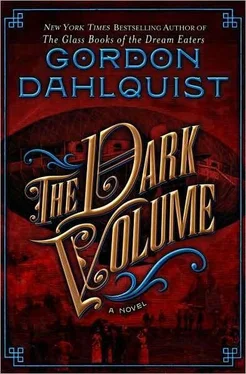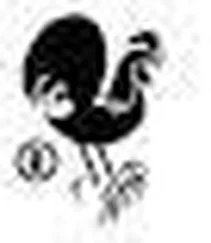Gordon Dahlquist - The Dark Volume
Здесь есть возможность читать онлайн «Gordon Dahlquist - The Dark Volume» весь текст электронной книги совершенно бесплатно (целиком полную версию без сокращений). В некоторых случаях можно слушать аудио, скачать через торрент в формате fb2 и присутствует краткое содержание. Город: New York, Год выпуска: 2009, ISBN: 2009, Издательство: Bantam Books, Жанр: Прочие приключения, на английском языке. Описание произведения, (предисловие) а так же отзывы посетителей доступны на портале библиотеки ЛибКат.
- Название:The Dark Volume
- Автор:
- Издательство:Bantam Books
- Жанр:
- Год:2009
- Город:New York
- ISBN:978-0-553-90603-5
- Рейтинг книги:3 / 5. Голосов: 1
-
Избранное:Добавить в избранное
- Отзывы:
-
Ваша оценка:
- 60
- 1
- 2
- 3
- 4
- 5
The Dark Volume: краткое содержание, описание и аннотация
Предлагаем к чтению аннотацию, описание, краткое содержание или предисловие (зависит от того, что написал сам автор книги «The Dark Volume»). Если вы не нашли необходимую информацию о книге — напишите в комментариях, мы постараемся отыскать её.
The Dark Volume — читать онлайн бесплатно полную книгу (весь текст) целиком
Ниже представлен текст книги, разбитый по страницам. Система сохранения места последней прочитанной страницы, позволяет с удобством читать онлайн бесплатно книгу «The Dark Volume», без необходимости каждый раз заново искать на чём Вы остановились. Поставьте закладку, и сможете в любой момент перейти на страницу, на которой закончили чтение.
Интервал:
Закладка:
Against his better judgment, Cardinal Chang slipped it into the pocket of his coat. In an afterthought he put the orange metal ring in with it. The clear glass cover he fit back over the empty hole.
The car's interior had been designed to resemble an elegant parlor: windows with tasteful sashes and drapery, carpets and stucco moldings, with the appropriate furnishings—all nailed down—an assortment of fauteuils and chaises and spindle-legged sideboards. Chang sneered at the desire to at all times be accompanied by the familiar. Did not the pleasure of having one's own railcar lay in its being exclusive and unique? The décor ought to be proudly unsuited to anyplace else , expressing the soul of this new environment of privilege. Instead, he saw the trappings of staid comfort, a train car styled on the anteroom of a gentleman's club—or, he sneered, a dirigible fitted with sofas. New places ought to be platforms of discovery, not merely venues for drinking port in a chair.
Not that Cardinal Chang drank port, but poverty of means did not contradict his conviction regarding his enemies' poverty of mind. And yet… the railcar was the work of the Comte d'Orkancz, hardly a slave to conventional taste. He looked around him more closely, and the interior began to take on a certain irony, precisely because of its banality. Now he saw the staid interior fittings were all an arrogant black—the carpet, the walls, the loops of stucco, even the upholstery— as if the comfort and security they projected was itself a source of wicked, contemptuous pleasure. The Comte was an artist, and he saw the world in terms of metaphor—however dark his sensibilities, the worlds he created remained expressions of beauty and wit. The elegant chaise was fitted with leather restraints. The wide, soft fauteuils bore lacquered trays that folded out like square wasp wings, where one might lay out food, drink… or medical implements.
Chang's amusement stuck in his throat. A ventilation grille had been set into the ceiling, and at his feet, in a pristine square of slate, lay a metal drain. The square of slate was edged with a thin band of orange metal, the same orange metal that ringed every bulb of glass. He looked up. The ventilation grille as well. And the stucco molding, running the entire circuit of the car, bore a line of orange the width of an infant's finger along its upper edge.
He took a breath and then sharply exhaled. The air in the railcar nearly vibrated with dread. On the far end of the room was a low wooden cabinet, its top wide enough to serve as a desk for examining the documents sequestered within its many thin drawers. To his right stood a more unusual fixture, braced at either end by mechanical standing cabinets—the same species, but not full-grown, as the brass-bound kiosks the Comte had used in the cathedral tower to transform his three women to glass. These versions bore fewer black hoses and brass switches, but the sight of them made Cardinal Chang's throat go dry. The black hoses ran into the side of the large object that lay between them, a high metal box the shape of a large coffin, with a curved lid of thick glass. This was where they had kept Angelique.
The glass cover was smoked and he could not see in. With a grimace Chang set his stick against the box, replaced his glove, and lifted the cover carefully with both hands, looking down with revulsion. The interior of the coffin, for he could call it no other thing, was lined with black rubber. Its center depression was dusted with a small ring of sediment, like the sigil of a parched, departed sea, the salts of her body—of whatever had been done to her—the waters all having dried away. His eyes flicked quickly about the box's interior—more tubes, and holes where liquid or gas had been pumped inside. Chang dropped the cover loudly back into place, his own breath coming raw with anger. He stalked to the cabinet, pulling open the drawers one after another, pawing the papers inside, until he realized he was not seeing them at all. He ought to feel none of this—it was nothing he had not seen before, nothing he had not resigned himself to bear. Chang pulled out his glasses. The blue glow made him squint.
He sorted the cabinet's contents with a grim concentration. One drawer was given over to the plans for the railcar itself, others held purely alchemical formulae—all of it in the same hand, assumedly the Comte's. Next came designs for various small machines. Here the Comte's notations were augmented by another hand, some pages attached with pins to others that were more technically detailed. These bore a different notation in the corner. Chang held it up to his eyes: a stamp of several horizontal lines, each of which was initialed. It was a way to track production, Chang realized—these were all designs for machines that had been made . The top lines were all initialed “Cd'O” … the second line—perhaps referring to the mechanical details, was initialed “GL” or “JC” —Lorenz or Crooner, engineers from the Royal Institute, recruited by the Comte to construct his fever dreams in iron and brass. A fourth line bore simply a stylized mark, identifying the Xonck Armament Works—indicating where the fabrication had been done—but the third line, in every instance, was initialed “AL” …
Every machine had been made for the Comte d'Orkancz by the Xoncks. The construction itself had been completely overseen by Alfred Leveret.
Chang went back to the case. Three drawers had been emptied. He assumed he would find specifications for the great cathedral tower, and for the creation of the glass books, but they did not appear. The rest held more alchemical scribbling, half-legible and meaningless to anyone save d'Orkancz. He shoved the last drawer home, and heard the rustle of something caught in it. Curious, Chang reached to the back of the drawer and found a balled-up piece of vellum, as if it had slipped out of the drawer above… one of the drawers that had been emptied. Chang carefully smoothed it out on the cabinet top.
It was smaller than the rest, and depicted a device the size of a black-powder pistol. The design was executed entirely in the hand of the Comte d'Orkancz, and labeled “marrow sparge” —an insidious term that meant nothing to Chang. There was no Xonck stamp in the corner. Had this implement been fabricated? Or did it exist solely in the Comte's ecstatic brain?
With a sudden curiosity Chang studied the tool's dimensions, and wondered—trying to recall the impression set into the velvet—if this, or something very like it, might have fit in the Contessa's mysterious trunk. He could not say. He stuffed it into the inner pocket of his coat.
NO DOUBT there remained more crucial information about the workings of the glass, but Chang knew it was beyond his own understanding. He wished Svenson were there—at least he understood the medical issues. It seemed inarguable that in the Comte's absence whoever did best understand the glass must destroy their rivals. Chang strode to the door, but then paused at a sudden impulse of responsibility. Working deliberately he began to dig the orange metal rings from one rack of glass, stuffing one after another into his pockets. He'd no idea of their value, but Svenson might, and if they gave any protection whatsoever, it was worth his hauling them around.
He abruptly looked up. A noise outside the car. Chang stepped to the door, listening carefully. There were voices, bootsteps. Without hesitation he eased the door closed, sealing himself in, and looked around the room, hating every inch of it, hating the fools outside who had trapped him.
The entire car lurched and Chang was nearly thrown to his knees, grabbing a rack of glass to stay upright. He cursed the black-painted windows and the thick steel doors. He could not hear a thing. The car shook again, and then settled into a regular rhythm. Chang wanted to spit with frustration. The black car was being collected. He was a prisoner.
Читать дальшеИнтервал:
Закладка:
Похожие книги на «The Dark Volume»
Представляем Вашему вниманию похожие книги на «The Dark Volume» списком для выбора. Мы отобрали схожую по названию и смыслу литературу в надежде предоставить читателям больше вариантов отыскать новые, интересные, ещё непрочитанные произведения.
Обсуждение, отзывы о книге «The Dark Volume» и просто собственные мнения читателей. Оставьте ваши комментарии, напишите, что Вы думаете о произведении, его смысле или главных героях. Укажите что конкретно понравилось, а что нет, и почему Вы так считаете.












